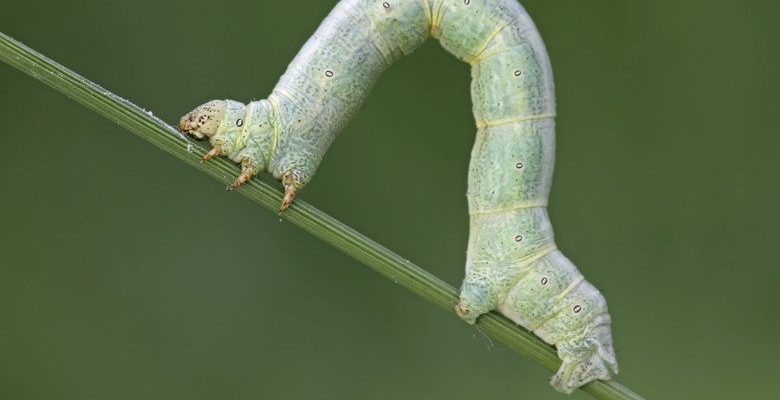
Now, let’s dive into this world where inchworms become something more. Picture this: a silent garden filled with life. Each inchworm represents a stage in nature’s grand play, and every native moth has its role and significance. As we explore this subject, we’ll uncover how these crawling creatures transform and what role they play in the ecosystem, all while fostering a deeper appreciation for the native moths that rely on them.
What Are Inchworms?
Inchworms are the larval stage of certain moth species, most notably from the Geometridae family. They’re remarkable for their unique movement – instead of crawling like typical caterpillars, they “inch” along. This is where their name comes from! When they move, it looks like they’re measuring the earth, hence the “inch” in inchworm. Their bodies are slender and can blend into the green surroundings, making them masters of camouflage.
These tiny creatures are usually found munching on leaves, which seems like a simple task. However, they play a crucial role in the food chain. Birds and other predators often rely on them for a snack, which means inchworms help transfer energy up the food web. You might be wondering how such a small creature can have such a big impact, but trust me, it’s all connected.
The Lifecycle of Inchworms
Let’s break down the life of an inchworm. It all starts with an egg, usually laid on the underside of leaves. When the larvae hatch, they start their life as tiny inchworms, focused on eating and growing. This stage is all about survival. They munch on the leaves around them, growing and preparing for the next phase.
After several weeks of feasting, inchworms are ready for the next step: pupation. Here’s the cool part – they find a safe spot, often under a leaf or in the soil, and transform into a pupa, or chrysalis. During this stage, they undergo a dramatic change, a bit like a superhero putting on their costume. After this period, they emerge as adult moths, ready to continue the cycle by mating and laying eggs. It’s a beautiful transformation that showcases nature’s wonders.
The Connection to Native Moth Species
Inchworms aren’t just fascinating for their lifecycle; they are also intimately connected to native moth species. Many native moths, including the *Luna Moth* and *Walnut Sphinx*, rely on these caterpillars during their development. As they munch on leaves, inchworms become a vital food source for moth species that reproduce in the same habitat.
Moths play a crucial role in our ecosystem, particularly as pollinators. They can transport pollen from one flower to another, helping plants reproduce. This means that inchworms, while they might seem small and insignificant, contribute to a larger cycle of life that supports diverse plant and animal species. It’s pretty amazing how interconnected everything is when you look closer.
Importance of Native Moths
Native moths, like the aforementioned examples, are often overlooked. But they play essential roles in maintaining the balance of our ecosystems. For one, they are crucial for pollination, aiding the growth of various plants, including many that provide food for other wildlife and even humans.
Moreover, native moths serve as indicators of environmental health. A diverse and thriving moth population often signifies a healthy ecosystem. When these species flourish, it suggests that their habitats are intact and that the ecosystem is functioning properly. It’s like nature’s way of giving us a thumbs-up.
You might be surprised to learn that many people unknowingly support these creatures by maintaining native gardens. By planting local flora, gardeners attract these beneficial moths and caterpillars, allowing them to thrive in their neighborhoods. It’s a simple yet significant contribution to environmental health.
Predators and Threats
While inchworms and native moths are crucial parts of the ecosystem, they also face numerous challenges. Birds, rodents, and other predators feast on them, but these natural enemies are part of maintaining balance. The problem arises when humans intervene. Pesticides and habitat loss pose significant threats to both inchworms and moths.
Habitat destruction, primarily due to urbanization and agriculture, has led to a decline in many native moth populations. This loss is worrying because it disrupts the balance in ecosystems. The more we lose these species, the more we risk throwing off the entire food chain.
To help inchworms and native moths, we can choose to create wildlife-friendly spaces, reduce pesticide use, and support local wildlife organizations. Every small action can contribute to preserving these beautiful creatures and their habitats.
The Future of Inchworms and Moths
Looking ahead, the future of inchworms and native moth species is deeply intertwined with human action. As we become more aware of the importance of these tiny creatures, we can make informed choices that positively impact their survival. Conservation efforts, habitat restoration, and public education can help preserve these vital species.
Additionally, making conscious choices in our gardens can promote the health of both inchworms and moths. By using native plants, limiting pesticide use, and advocating for wildlife conservation, we can create spaces where these species can thrive.
It’s all about making changes that benefit not only these small creatures but the entire ecosystem. After all, in the grand scheme of things, every inchworm counts.
In summary, the lifecycle connection between inchworms and native moth species highlights the intricate web of life that surrounds us. These tiny inching creatures play a vital role in the ecosystem, serving as both food sources and indicators of environmental health.
As we work towards protecting these species and their habitats, we not only help inchworms and moths but also contribute to the broader health of our planet. So, next time you spot an inchworm on a leaf, take a moment to appreciate the journey it’s on and the connections it represents. Nature is indeed a wondrous place, and every creature, no matter how small, has its part to play.

